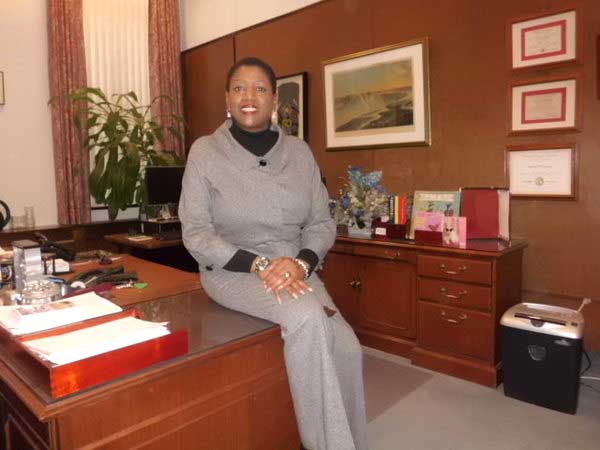 |
| Garbage expert Donna Owens plan was so flawed she cried when challenged. |
|
|
|
Third Street businessman Craig Avery lambasted City Administrator Donna Owens and called for her resignation at a public meeting two weeks ago – an event that went unreported in the local daily newspapers.
He followed up with an internet article on his Niagara Hub website (niagarahub.com), writing that Owens should "take the next train out of town."
At the meeting, several witnesses said that Owens was visibly shaken and reduced to the point of tears. City Councilmen Andrew Touma and Bob Anderson came up from the audience to mercifully end the meeting, which was held in City Council chambers.
The city had negotiated a garbage hauling agreement behind closed doors with Modern Disposal Corp. of Lewiston. Owens and her boss, Mayor Paul Dyster, negotiated the deal.
Apparently, Owens was qualified to negotiate the garbage deal because of her brief experience as deputy commissioner of solid waste services for the city of Atlanta, Ga.
Among other things, the Owens-Dyster plan calls for city residents to reduce their garbage output each week to what can be placed inside a 64 gallon tote, the lowest size tote for garbage in any community.
Under the new plan, nothing else can be placed at the curb except recyclables.
Summer grass clippings, in particular, are expected to be problematic for city residents, unless modifications to the plan are negotiated.
According to City Hall officials, people may be able to rent an additional bin for $700- 1,000 a year.
Lockport, which is also served by Modern Disposal, charges only $50 per year more for extra 96-gallon refuse carts.
Many communities, including some served by Modern, also allow residents to purchase extra garbage bags for $2 per bag in a pay-as-you-throw plan.
Some critics charge that some city residents will not rent an extra bin but throw their garbage in alleys and abandoned lots.
Dyster had previously said he expected a $500,000 savings with his new plan. However, these savings, in order to be realized, assumed a drastic cut in garbage and a dramatic increase in the amount of recycling.
 |
| The Dyster garbage plan will not pick up garbage in the street. |
|
|
|
Presently about four percent of curb waste in Niagara Falls is recycled, the lowest in the region.
In order for there to be savings, Niagara Falls would have to rise from the poorest recycling rate in the area (four percent) to levels that equal or exceed Amherst, the highest recycling municipality in the area at 25 percent.
The bulk of the proposed savings will be at the expense of more than 500 businesses which, according to the plan, will no longer receive curbside garbage service.
Talks are underway, the Reporter has learned, to include some 200 businesses that were planned to be cut, and put them back on the list of stops for Modern at an additional cost.
Currently, Modern is required to pick up all garbage placed at the curb by residents and small businesses.
As a sign of the chaotic roll-out of the plan, a terse and unsigned note was received from City Hall by Niagara Falls businesses two weeks ago:
"Dear Commercial Property Owner," it began.
"Effective July 1, 2014, the City of Niagara Falls is transitioning to a wheeled cart or tote based Refuse and Recycling Collection Program.
"Since the City will no longer be able to provide services to your property, you are strongly encouraged to procure private collection services."
The unsigned letter was dated June 3, which happens to be the same day the Niagara Falls Reporter announced the terms of the city's secret contract with Modern.
A meeting was scheduled two days later to explain to business owners why they were not going to get service anymore.
Community activist Ken Hamilton, who attended the meeting, wrote on his Niagara Community Forum Facebook page that Owens reacted at first by turning angrily on the crowd.
"She chastised the audience and the city for not embracing what she considered as positive change," Hamilton wrote.
During the meeting, Owens seemed unable to answer questions concerning the contract she oversaw.
Why, for example, is the amount of garbage residents are permitted to throw out less than two-thirds of the accepted industry standard throughout the United States?
Why, at 96 gallons, is the size of recyclable container larger than any municipality?
An internet search of trash collection of municipalities shows most cities have 96 gallon garbage totes and 64 gallon recycling totes. Why did Niagara Falls reverse this trend and make the garbage totes 64 gallons and the recycle totes 96 gallons?
Why were negotiations with Modern carried out behind closed doors, with no opportunity for city residents and business owners to comment on a contract they will, absent changes to the agreement, be forced to live with?
The true impact of the Owens-Dyster plan was not realized by residents and business owners until the Reporter announced the real plans.
According to the letter sent by City Hall, businesses have less than 60 days in which to find alternative private companies to pick up their trash.
|


